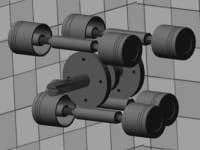The attached figures are of the proof-of-concept prototype Fijalkowski engine, without crankshaft and connecting rod (conrod) mechanisms (C2M), The base internal combustion engine (ICE) concept is that of a common-axis, two-cylinder module incorporating the cylinders, cylinder heads and pistons of the ICE. By using a number of commercially available nano-magneto-rheokogical fluid (NMRF) rotary clutches, acting as NMRF rotary ratchets of an NMRF linear motion-rotary motion/rotary motion-linear motion (LM-RM/RM-LM) and/or rotary motion-rotary motion (RM-RM) mechatronic-commutator with a 2.0-in. stroke was designed to operate with the 2.36-in. bore of the ICE. This NMRF LM-RM/RM-LM and/or RM-RM mechatronic-commutator allows the purely LM of the pistons and connecting rods to be converted to RM by keying one or both output drive shafts to its associated NMRF rotary ratchets to provide one revolution of the output shaft for every cycle of the pistons. In this configuration the shaft could drive an AC-DC electronic-commutator synchronous generator.
The NMRF LM-RM/RM-LM and/or RM-RM mechatronic-commutator principal benefit is to provide the piston with a connecting rod attachment that eliminates all angular thrust between the piston and cylinder wall. In this version, primary and secondary dynamic balance is achieved without the addition of any parasitic masses. This NMRF LM-RM/RM-LM and/or RM-RM mechatronic-commutator allows the purely LM of the pistons and connecting rods to be converted to RM by keying an output driveshaft to its associated NMRF rotary ratchets to provide one revolution of the output shaft for every cycle of the pistons.
The NMRF LM-RM/RM-LM and/or RM-RM mechatronic-commutator principal benefit is to provide the piston with a connecting rod attachment that eliminates all angular thrust between the piston and cylinder wall. There is not traditional C2Ms. The Fijalkowski engine offers simple dynamic balancing because of no secondary (conrod) forces.
• The inertial acceleration and force simulations show that the ICE inertia reaches optimal, perfectly sinusoidal, curves for piston speed, acceleration and piston force, which no ICE with conrods can achieve.
• The volumetric expansion curve is ‘flatter’, because of the geometry. This slower volumetric expansion above the piston head of the ICE is a significant advantage, because the peak pressure occurs between 11 and 22 degrees during the work stroke. Smaller space, ignition and explosion, larger piston thrust, higher torque.
• The Fijalkowski engine has fewer friction surfaces than a conventional ICE.
• The piston to cylinder side-wall forces are estimated to be about 40% lower, because the Fijalkowski engine has an integrated piston structure, and no connecting rods.
• Cumulatively, the ICE engine friction has been estimated to be 40% lower than that of a comparable size conventional ICE.
• The Fijalkowski engine has fewer ICE components and parts; fewer moving parts. The NMRF LM-RM/RM-LM and/or RM-RM mechatronic-commutator combination forms an integrated unit, and rotates as one unit, and each cylinder pair has an integrated piston pair moving as one unit, respectively.
• Lower manufacturing and assembly costs because of fewer ICE parts and components.
Like this entry?
-
About the Entrant
- Name:Fijalkowski Bogdan
- Type of entry:individual
- Patent status:none








